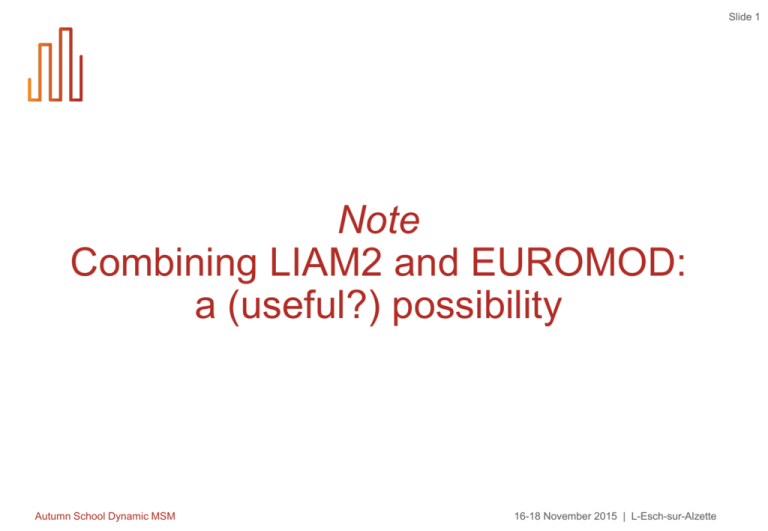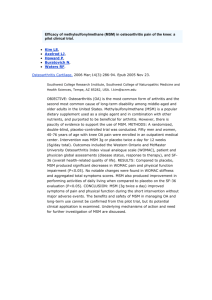section11 LIAM2 EUROMOD
advertisement

Slide 1 Note Combining LIAM2 and EUROMOD: a (useful?) possibility Autumn School Dynamic MSM 16-18 November 2015 | L-Esch-sur-Alzette Slide 2 Motivating the combination (*) Given complexity of microsimulation models, hence development costs, it is often useful to raise the question of a combination of tools rather than parallel compositions This is particularly true as soon as the static model EUROMOD (Sutherland et al.) and dynamic models built from LIAM2 (O’Donoghue et al., Dekkers et al.) are considered Their internal structure, including variables needed for simulation, and their technical implementation show similarities that make an interaction a priori promising We explain how it is feasible, emphasize limits of the exercise + example of application if time left (*) Liégeois Ph. and G. Dekkers, (2014), Combining EUROMOD and LIAM Tools for the Development of Dynamic Cross-sectional Microsimulation Models : a Sneak Preview, in G. Dekkers, M. Keegan and C. O’Donoghue (eds), New Pathway in Microsimulation, Burlington : Ashgate Autumn School Dynamic MSM 16-18 November 2015 | L-Esch-sur-Alzette Option E=>D : feeding the dynamic What’s at stake ? Reforms of Tax-benefit systems Demographic changes Modifications of Employment status Autumn School Dynamic MSM model from EUROMOD (for T-B) Option D=>E : “dynamizing” the EUROMOD framework e.g. for “nowcasting” : Gross Income variations Macro adjustments 16-18 November 2015 | L-Esch-sur-Alzette Slide 3 Slide 4 How proceeding ? STEPS TASK REMARKS 1 Preparing input dataset for MiDAS_LU (LIAM2) Cross-sectional instance, maybe with some lifecycle information (e.g. incomes, for pensions) 2 Running MiDAS_LU Outputs : households and individual socio-economic characteristics & incomes for several subsequent years 3 Preparing inputs datasets for EUROMOD from MiDAS_LU output - A few variables may have to be redesigned when definitions inconsistent in static and dynamic frameworks, whatever D=E / E=>D - More importantly, some variables may miss (e.g. capital income), which may be limitative especially if Option D=>E 4 Preparing parameter sheets for future public policies in EUROMOD - Parameters (e.g. tax rates), but also the policy design (which policies to be simulated, which variables involved) - - May be a demanding process if Option E=>D 5 Running EUROMOD Outputs : TXT files 6 Combining Results Either within MiDAS_LU (hence EUROMOD outcome back to the dynamic model) or outside (e.g. STATA) Autumn School Dynamic MSM 16-18 November 2015 | L-Esch-sur-Alzette Slide 5 Conclusions : (reminding) remarks & limitations Option D=>E : MiDAS_LU “feeding” EUROMOD for demog & gr. income The dynamic model does not generate all information (capital income, maintenance payments, etc) available in the static model (based on survey data) In particular, the dynamic model generates “nuclear” households (parents + children) rather than standard “residence” households Some gap between input data (situation observed in year t) and first output data (simulation for t+1 on), in the dynamic model “Weighting” of households (survey data) to be addressed in dyn MSM Option E=>D : EUROMOD “replacing” the T-B module in Dyn. Model Given limitation in the design of policies in dynamic modelling framework, EUROMOD must be recomposed for this specific use Both options : Common variables needed & T-B cannot play a role on demographic & socio-economic status (one-way impact) Autumn School Dynamic MSM 16-18 November 2015 | L-Esch-sur-Alzette Slide 6 Example (*): Reform of the Tax-Benefit System & Evolution of the gross Income (2008-2018) A simple evolution is considered: Hourly wage : nominal (Consumer Price Index :+ 2.5%/year) and real annual growths Income taxation : change of tax brackets (conformly to the CPI:+ 2.5% / year) Family allowances : one-shot increase in 2013 : + 2.5% ^ 5 Several social references & thresholds uprated through a central parameter so-called “Minimum Social Wage” : CPI & real growth of the hourly wage Social assistance indexed on consumer prices What about outcomes if “dynamics” is introduced ? (*) Liégeois and Dekkers (2014) Autumn School Dynamic MSM 16-18 November 2015 | L-Esch-sur-Alzette Slide 7 Analysis of Results : Population vs T-B effects 3 basic views simulated : All fields concerned (“POL_POP”) Population and gross Income fixed at their 2008 level ; Tax-Benefit system evolving, population and gross earnings fixed (“POP_2008”) Tax-Benefit system fixed at its 2008 level ; Population and gross earnings evolving (“POL_2008”) Autumn School Dynamic MSM 16-18 November 2015 | L-Esch-sur-Alzette Slide 8 Analysis of Results : Population vs T-B effects 3 basic views simulated : All fields concerned (“POL_POP”) Population and gross Income fixed at their 2008 level ; Tax-Benefit system evolving, population and gross earnings fixed (“POP_2008”) Tax-Benefit system fixed at its 2008 level ; Population and gross earnings evolving (“POL_2008”) Autumn School Dynamic MSM 16-18 November 2015 | L-Esch-sur-Alzette Slide 9 Analysis of Results : Population vs T-B effects 3 basic views simulated : All fields concerned (“POL_POP”) Population and gross Income fixed at their 2008 level ; Tax-Benefit system evolving, population and gross earnings fixed (“POP_2008”) Tax-Benefit system fixed at its 2008 level ; Population and gross earnings evolving (“POL_2008”) Autumn School Dynamic MSM 16-18 November 2015 | L-Esch-sur-Alzette




